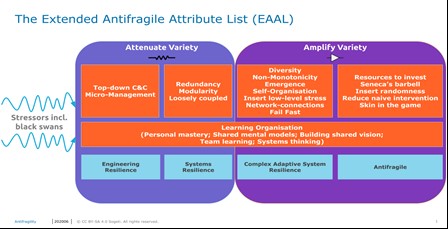Turbulent times ask for resilient organizations
The financial crisis of 2008, the dotcom crisis of 2000 and the current crisis of 2020, all highlight the need for organizations to become resilient or even antifragile to survive (unexpected) external stressors so that they continue to remain significant for their stakeholders.
————-
So, what is antifragility, and what is its application in organizational design?
In my master thesis titled “Defining Antifragility and the application on Organisation Design,” I have combined research literature on resilience with antifragile attributes, as well as a variety of engineering models to form the Extended Antifragile Attribute List (EAAL) model.
But before we delve deeper into the EAAL model, let’s look at EAAL’s conceptual model.
We all know that the challenge for organizations is to stay relevant in the current Volatile, Uncertain, Complex and Ambiguous (VUCA) world and regain their ‘value’ after being disrupted by a stressor. To deal with the VUCA world, enterprises need to be resilient and agility is one of the tools for achieving it.
To survive all the stressors, being resilient is not enough. There will be stressors that are outside of what a resilient system can absorb. These stressors are called Black Swans. To survive a black swan event, an enterprise needs to be antifragile. Figure 1 below contains the behavior of a system on stress or time resulting in a value.
Resilience and antifragility by Nassim Nicholas Taleb and P. Martin-Breen

(Figure 1)
The EAAL model
The Extended Antifragile Attribute List (EAAL) model is a summary of the available literature on the attributes of a resilient and antifragile system-of-systems validated by experts and C-level management.
This model is the first step in the design process of a resilient or antifragile organization, and it proved to enable C-level managers to determine the level of resilience (Figure 1) that (parts of) the enterprise needs to have. It also enabled leaders to determine the attributes (Figure 2 below) needed to develop the selected behavior.

(Figure 2)
This study (see below) can be extended to the practitioner’s review by design authorities outside of the organizational domain. However, a follow up study is needed on the causal relationship between the attributes and the behavior of the system.
Note: The content of this blog is a summary based on my Master’s research thesis:
Defining Antifragility and the application on Organization Design – a literature study in the field of antifragility, applied in the context of organization design (available as open access).
Do you want to know more or are you interested in a video call to discuss the topic in detail? Please feel free to contact me. The research is pretty dense, and it would be my pleasure to discuss it with you.

 English | EN
English | EN 